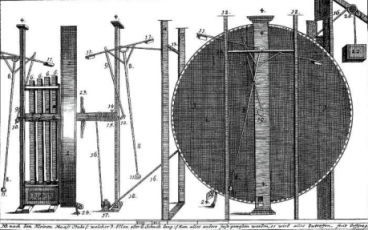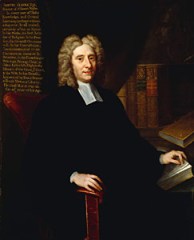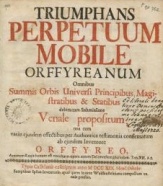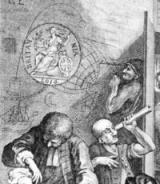 A diagram of a perpetual-motion wheel built by Johann Bessler. From Orffyreus, Grundlicher Bericht von dem Perpetua ac per se Mobili (1715)
A diagram of a perpetual-motion wheel built by Johann Bessler. From Orffyreus, Grundlicher Bericht von dem Perpetua ac per se Mobili (1715)
In this post we look at Simon Schaffer’s “The Show That Never Ends: Perpetual Motion in the Early Eighteenth Century,” British Journal for the History of Science 28 (1995): 157-189, in which he sets himself the task of explaining the intellectual and political viability of perpetual motion schemes, particularly in “the lands dominated by the Hapsburgs, the Empire and northern Italy” (162). This is a difficult challenge, since, as Schaffer points out, such machines had been subjected to widespread doubt and criticism from the middle of the seventeenth century. Yet, they did have a place, and what Schaffer, I think, accomplishes here is that he makes that place fit more coherently into what we know about how, in general, engineering and philosophical novelties were handled in the early 18th-century milieu.
The most important move that Schaffer makes is to make clear that the strict categorization of perpetual motion machines as impossibilities was a distinction that turned on philosophical concerns that were both subtle, and, in certain philosophical circles, open to dispute. Specifically, at that time, the universe itself was widely thought of as, effectively, a perpetual motion machine. Thus, the impossibility of perpetual motion was predicated on a differentiation between external and internal drivers of a machine, between machines without external drivers that could move forever and ones that could do useful work, and, indeed, between nature and artifice. These distinctions might well have clear significance to natural philosophers and engineers. They were perhaps less clearly significant at court where perpetual motion schemes mixed with schemes for novel machines—particularly hydraulic automata and steam engines—that were merely perpetually moving.
 Notably, the eminent historian and philosopher to the court at Hanover, Gottfried Leibniz (1646-1716), was a major proponent of useful mechanisms, such as ones he unsuccessfully proposed to mechanize mining operations in the Harz Mountains (links are to the recent work of Andre Wakefield on this). According to letters he wrote to Duke Johann Friedrich in the late 1670s, an invention that relieved labor, “so to speak, makes my capital.” It would “have the effect and advantage of a perpetual motion, though,” he was careful to note, “it is no such thing: for this perpetual motion, such as is sought, is impossible” (164).
Notably, the eminent historian and philosopher to the court at Hanover, Gottfried Leibniz (1646-1716), was a major proponent of useful mechanisms, such as ones he unsuccessfully proposed to mechanize mining operations in the Harz Mountains (links are to the recent work of Andre Wakefield on this). According to letters he wrote to Duke Johann Friedrich in the late 1670s, an invention that relieved labor, “so to speak, makes my capital.” It would “have the effect and advantage of a perpetual motion, though,” he was careful to note, “it is no such thing: for this perpetual motion, such as is sought, is impossible” (164).
The philosophical possibility of perpetual motion would later become a bone of contention in Leibniz’s bitter disputes with the followers of Isaac Newton (1642-1727). Newton held the effects of gravitation to make the universe unstable, requiring continual divine intervention. Leibniz found this argument theologically unsatisfying, writing in 1715 that in his enemies’ view, “God had not sufficient foresight to make a perpetual motion.”
 Clarke
Clarke
Court chaplain and Newton acolyte Samuel Clarke (1675-1729) countered that secular standards of skillful artifice emphasizing the lack of need to intervene with machines once set in motion did not apply to God who “not only composes and puts things together but is himself the author and continual preserver of their original forces or moving powers.” This argument likewise had analogies in political philosophy, as, Clarke argued, claims that the universe is self-sustaining were akin to reckless claims that “in an earthly government things may go on perfectly well without ordering … anything” (165).
Of course, the rulers of the time were generally eager to demonstrate the orderliness and prosperity of their domains, and to portray this orderliness and prosperity not as requiring continual intervention, but as a more natural consequence of the virtues of their absolutist regime.
Part of these virtues entailed the wise use of patronage. Rulers could support practical inventions and works—windmills, waterwheels, public clocks, mines and metallurgical works, and steam engines—which augmented the commerce of their lands, while simultaneously displaying prestige. Accordingly, they often found automated spectacles to be a fitting symbol of their power. They commissioned the construction of lifelike clockwork automata and hydraulically sophisticated fountain displays, which could amuse guests, while, of course, conveying important political lessons. According to Schaffer (161):
Perpetual-motion machines were apt occupants of the courtly and academic world of baroque absolutism and were easily understood as emblems of the permanent workings of the divinely ordered world-machine and thus the rationally managed state.
Here’s an American video on behalf of Austrian tourism, which briefly shows the fountain-works and automata at Schloss Hellbrunn near Salzburg. Although it, unsurprisingly, doesn’t catch the symbolic function of the palace’s waterworks and automata—for that, see Elly Truitt’s blog, Medieval Robots—it actually does relate a bit of the symbolism built into the grotto of ruins:
http://www.youtube.com/watch?v=UeoR6WcIdG0
 To compete for support in this world, projectors and natural philosophers had to understand and exploit its rules. On this issue, we can understand “The Show That Never Ends” as existing in a larger historiography of the time, focusing on a slightly earlier period, which included Bruce Moran’s The Alchemical World of the German Court: Occult Philosophy and Chemical Medicine in the Circle of Moritz of Hessen (1991), Pamela Smith’s The Business of Alchemy: Science and Culture in the Holy Roman Empire (1994), and Mario Biagioli’s Galileo, Courtier: The Practice of Science in the Culture of Absolutism (1994).
To compete for support in this world, projectors and natural philosophers had to understand and exploit its rules. On this issue, we can understand “The Show That Never Ends” as existing in a larger historiography of the time, focusing on a slightly earlier period, which included Bruce Moran’s The Alchemical World of the German Court: Occult Philosophy and Chemical Medicine in the Circle of Moritz of Hessen (1991), Pamela Smith’s The Business of Alchemy: Science and Culture in the Holy Roman Empire (1994), and Mario Biagioli’s Galileo, Courtier: The Practice of Science in the Culture of Absolutism (1994).
In absolutist courts one had to put on a display showing that one was worthy of patronage. There were always risks in this process, since failure could result not simply in a failure to gain backing, but in being humiliatingly discredited by one’s opponents. The engineer, inventor, and persistent critic of perpetual-motion machines Denis Papin (1647-1712?)—who had already worked for Christiaan Huygens and Robert Boyle—struggled to win patronage for his early steam engine in Kassel in the early 1700s. His “reputation was not helped when one of his engines blew up, wounding the Landgrave himself. After complaining of the presence of ‘many over-powerful enemies’, Papin packed his bags and returned to London” (170), where success would continue to elude him up to his unrecorded death.
 Bessler’s 1719 book
Bessler’s 1719 book
One could, however, manage the risks of a demonstration by cheating. Notably, one was not necessarily obligated to divulge all of one’s secrets in a demonstration at court, because it was allowed that one has a right to protect one’s inventions. Johann Bessler (c1680-1745), called “Orffyreus”, refused to submit to inspection the interior of a self-propelled wheel (see the top of this post), which he successfully demonstrated at Kassel in 1721. Although he was ultimately unsuccessful in securing any payment for his wheel, he did manage to win substantial credulity and interest in his claims prior to his failure.
If concealment was not out of the ordinary in demonstrations, incredulous natural philosophers could claim it was the place where an external driver of a machine was likely to be located. Schaffer (as is his wont) expends some effort in highlighting and problematizing philosophers’ attempts to present themselves, by virtue of their “command of abstract rational principles” (159), as authoritative arbiters of inventors’ and projectors’ claims. This, itself, was a potentially valuable social role as various investment schemes pervaded the early 18th-century. Notoriously, the South Seas bubble burst in 1720. In that world credulity, credibility, and financial credit were intimately related, and always suspect.
Philosophers’ objective, then, was to protect against deceitful and vulgar attempts to gain financial advantage by reinforcing a general perception of the impossibility of perpetual motion schemes by subjecting them to ridicule, a favorite courtly weapon,* and to make themselves into heroes in the story their defeat. Such stories were in turn part of a larger “enlightened historiography” relating “the inevitable and principled establishment of the equipoise of social prudence against popular delusion and baroque fantasy” (160). Thus the story of Bessler’s deserved humiliation—how he smashed his machine in response to the persistent queries of Leiden natural philosopher Willem ‘s Gravesande (1688-1742), and how a female servant supposedly secretly powered the wheel from an adjacent room—became an oft-repeated morality tale.
The move of attempting to draw a stark boundary between the plausible and the impossible was common at the time. As Lawrence Principe has more recently pointed out, it was at this same time, in the early 18th century, that a clear distinction between discredited alchemy and credible chemistry (subjects also dependant upon court patronage) was drawn, even though there were no new reasons to suppose that chrysopoeia (alchemical metallic transmutation) was impossible. Later, in 1775, the Académie des Sciences in Paris actually banned consideration of perpetual motion schemes.
Of course, natural philosophers were not always cooperative in efforts to show a united front on every issue. Notably, ‘s Gravesande, a harsh critic of speculative bubbles and, at one time, a reliable Newtonian, came to allow that perpetual motion might in fact be possible. As we saw in Part 2 of this series, in 1721 ‘s Gravesande developed experiments (in collaboration with instrument-maker Jan van Musschenbroek, of later Leyden jar fame [actually, that was his brother Pieter]), in which he measured the impressions made in wax by rigid balls falling from various heights. These measurements, he claimed, validated the Leibnizian vis viva concept.
However, ‘s Gravesande also wedded the vis viva concept to the Newtonian concept of active principles (e.g., gravity or magnetism), with which matter could be endowed. Contra both Newton and Leibniz, then, ‘s Gravesande held that active principles could be used to replenish motion in a self-contained device. This position was backed by Johann Bernoulli (1667-1748), who was then locked in the dispute over the origins of the calculus with Newton’s followers. He reckoned that a “mixed perpetual motion, that is, one where art and nature combine to perpetuate the motion” (180), might well be possible. Although ‘s Gravesande would ultimately play a key role in the downfall of Bessler at Kassel, at that moment his and Bernoulli’s tentative support was elemental in building widespread interest in Bessler’s wheel.
 The Board of Longitude papers project’s unoffocial logo: a madman trying to find the longitude; from William Hogarth’s Rake’s Progress (1735).
The Board of Longitude papers project’s unoffocial logo: a madman trying to find the longitude; from William Hogarth’s Rake’s Progress (1735).
I have pointed out before that, inasmuch as Schaffer critiques the moral-laden fables of “enlightened” history, he habitually structures his own histories around the favorite morals of the science-studies discipline. These morals generally involve the deep difficulties in controlling processes of rational assent. This piece, of course, illustrates why, well after the early 18th century, perpetual motion schemes could continue to attract interest and credulity. An important counterpart lesson is that incredulity could also be built around schemes that were not strictly impossible according to philosophers and engineers. As the Cambridge-Greenwich Board of Longitude papers project (of which Schaffer is PI) emphasizes, in the early 18th century finding the longitude at sea was often depicted as a fool’s errand, culturally equivalent to building a perpetual motion machine or transmuting lead into gold.
—
*Incidentally, the 1996 French film Ridicule is an excellent take on the “medical Enlightenment” and its dependence upon, and tension with, the courtly culture of the ancien Régime.